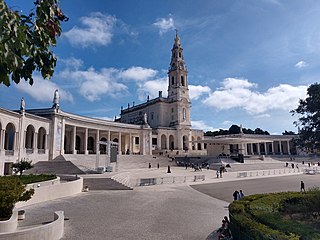
Fátima is a city in the municipality of Ourém and district of Santarém in the Central Region of Portugal, with 71.29 km2 of area and 13,212 inhabitants (2021). The homonymous civil parish encompasses several villages and localities of which the city of Fátima is the largest.
Talian, or Brazilian Venetian, is a dialect of the Venetian language, spoken primarily in the Serra Gaúcha region in the northeast of the state of Rio Grande do Sul in Brazil. It is also spoken in other parts of Rio Grande do Sul, as well as in parts of Espirito Santo and of Santa Catarina.

The Church of Our Lady of Sorrows is a Roman Catholic church in Póvoa de Varzim, Portugal. It is located in Largo das Dores square, in the old town of Póvoa de Varzim, and is part of the parish of Matriz. The church is dedicated to Our Lady of Sorrows, Nossa Senhora das Dores in Portuguese.
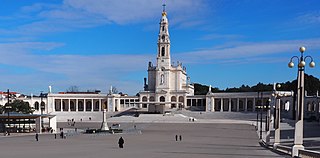
The Sanctuary of Fátima, officially titled Sanctuary of Our Lady of the Rosary of Fátima, is a Marian shrine dedicated to Our Lady of Fatima located in Fátima, in the municipality of Ourém, in Portugal. It consists of a group of Catholic religious buildings and structures with the Basilica of Our Lady of the Rosary as the main building.
The Holy Week in Braga is the most imposing, attractive and famous among all in Portugal, and the most important tourist and religious event in the city of Braga. It is estimated that about 100.000 people attend the major processions. It combines harmoniously elements of the liturgy and of popular piety, ancient traditions and innovation. Since November 2011, this event is officially “Declared of Interest to Tourism”.

The Cult of the Lord Holy Christ of the Miracles, popularly known as Senhor Santo Cristo or Santo Cristo dos Milagres is a religious veneration associated with an image of Jesus Christ, depicted in the events of the New Testament. The wooden image of Christ, by unknown artist, in a Renaissance-style representation of the Ecce Homo, represents the episode of Jesus of Nazareth's life when the martyred religious figure was presented to the crowd following his whipping, and includes a crown of thorns, uncovered torso and bruised/beaten body. Narrated in the New Testament, the artist represented in grande artistic style the contrast between violence on the body and the serenity of the expression, emphasized by the gaze from the image.
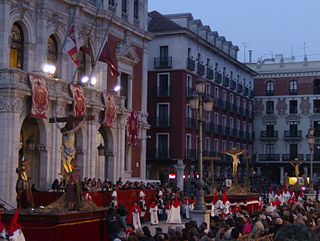
The Holy Week in Valladolid is one of the main tourist attractions, and cultural and religious events of Valladolid and the surrounding province during Holy Week in Spain. It boasts of renowned polychrome sculptures, created mainly by sculptors such as Juan de Juni and Gregorio Fernández, who were active when the city served as the imperial court. The city's National Sculpture Museum has a total of 42 images for the processions. The Holy Week in Valladolid is known to depict the Passion with great fidelity, rigor and detail.

The Basilica of the Immaculate Conception, or the Basilica of the Conception, is a church in Salvador, Bahia, Brazil. It is affiliated with the Catholic Church and was built in 1623, making it one of the oldest parishes in the Roman Catholic Archdiocese of São Salvador da Bahia. It was the first church built by the first governor-general of Brazil, Tomé de Sousa. The current structure was prefabricated in Portugal and assembled in Salvador; its construction began in 1739 and ended in the mid 19th century. The art historian Germain Bazin classifies the church as Portuguese in design, rather than part of the Bahian tradition of religious structures of the 17th and 18th century.
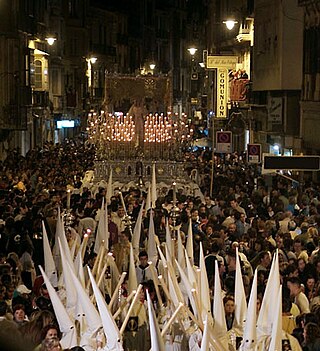
Holy Week in Málaga, is the annual commemoration of the Passion of Jesus in Málaga, Spain. It takes place during the last week of Lent, the week immediately before Easter. It is one of the city's main cultural and religious events.

The Chapel of the Holy Body is an 18th-century Roman Catholic church in Salvador, Bahia, Brazil. The church is dedicated to Saint Peter González; Saint Joseph is also venerated by the congregation. It belongs to the Roman Catholic Archdiocese of São Salvador da Bahia. The church is the seat of the Brotherhood de São José do Corpo Santo, which also manages the property. A large scale image of Our Father of Salvation attributed to Francisco das Chagas is located in the church.

The Royal and Venerable Confraternity of the Most Blessed Sacrament of Mafra, alternatively, the Royal and Venerable Brotherhood of the Most Blessed Sacrament of Mafra, is a public association of faithful of the Catholic Church, canonically established in the Basilica of Our Lady and Saint Anthony of Mafra, Portugal.
The 2021 Campeonato da Primeira Divisão de Futebol Profissional da FGF - Divisão Especial - Série A1, better known as the 2021 Campeonato Gaúcho, was the 101st season of Rio Grande do Sul's top flight football league. The competition was played from 27 February to 23 May 2021. 12 clubs contested in the Campeonato Gaúcho. Grêmio were the three-time defending champion and successfully defended their title.
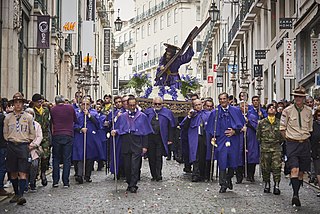
The Procession of Our Lord of the Passion of Graça, alternatively, the Procession of Our Lord of the Stations of the Cross of Graça) is one of the oldest and most important religious processions, which takes place yearly in the city of Lisbon, Portugal, on the Second Sunday of Lent. The procession has been held uninterruptedly since 1587, and it is organised by the Royal Brotherhood of the Holy Cross and Stations of the Cross of Graça.

The Municipal Museum of Caxias do Sul is a Brazilian historical, artistic, and ethnographic museum, located at 586 Visconde de Pelotas Street, in Caxias do Sul, in the state of Rio Grande do Sul.

Júlio de Castilhos Avenue is the oldest street in the Brazilian city of Caxias do Sul. Its route incorporated an old indigenous path, and until the first decades of the 20th century, it was nothing more than an unpaved road, even though it was the city's main street from the beginning. Later, it was extended, urbanized and ornamented, remaining with a straight line, with the exception of its end. Its current limits are the Getúlio Vargas Square, in front of the National Monument to the Immigrant, to the east, in Petrópolis neighborhood, and the junction with Rubem Bento Alves Avenue, to the west, in Cinquentenário neighborhood. Its evolution is intertwined with the history of Caxias, whose urban center remains as the main point of the city, and still holds several architectural examples of interest.

The Zambelli Family was formed by Italian-Brazilian artists who lived in Caxias do Sul and dedicated especially to sacred statuary and decoration of temples and residences. The Zambelli became well-known in the Italian-settled region of Rio Grande do Sul, founding a popular and long-lasting artistic tradition.
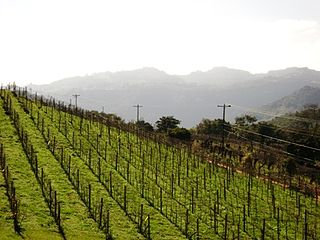
The Região da Uva e Vinho is a Brazilian tourist zone located in the northeast of the state of Rio Grande do Sul. It encompasses municipalities with the highest grape and wine production in the country. This condition has turned the region into one of the most important tourist hubs in Rio Grande do Sul, attracting hundreds of thousands of tourists from Rio Grande do Sul, other Brazilian states, and even other countries.

The Minor Basilica of Our Lady of Sorrows is the oldest standing Catholic temple in the Brazilian city of Porto Alegre, in the state of Rio Grande do Sul. Its construction lasted a considerable time and the design of the facade, which was modified even before it was inaugurated, today features an eclectic style. However, the interior is richly decorated with gilded woodwork in a late Baroque style with neoclassical elements and has an important group of life-size Baroque statues of Christ representing the cycle of the Passion.
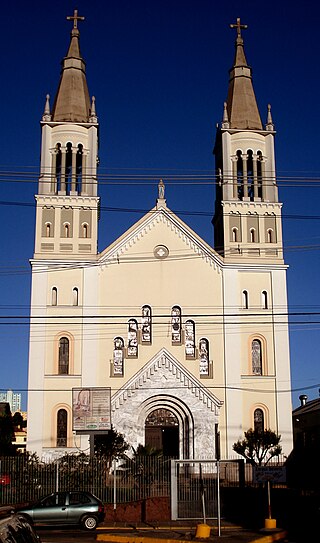
The Church of Our Lady of Lourdes is a Catholic temple located in the Brazilian city of Caxias do Sul, in Rio Grande do Sul. The Parish of Our Lady of Lourdes was created on February 8, 1942, by decree of Bishop José Barea. It was the first parish to be separated from the Parish of Saint Theresa, which was the only one in the urban area of Caxias do Sul until 1942. Father Maximiliano Franzoi was appointed its first parish priest in the same ceremony. Upon its creation, the Parish of Our Lady of Lourdes extended over a large area that was still only partially urbanized.



















